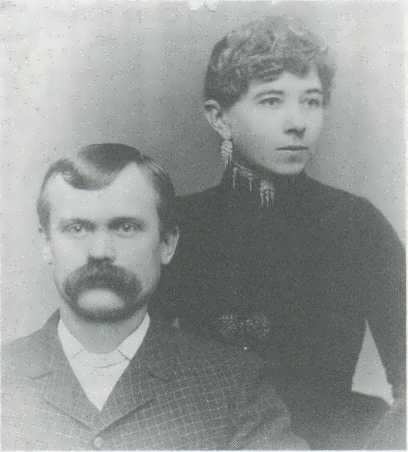Per first settled in Hanover Twp., Allamakee Twp. In 1856 he moved to Sec. 24, Pleasant Twp., Winneshiek Co. where he bought 40 acres along the Walnut Creek. This place is now known as the “Coon Club Cabin". The log house on this place had been built in 1851 from timber cut on the surrounding hills. The farm only had 10 acres that was tillable. As he had done in Norway, Per farmed with oxen. He had two cows, three sheep, one pig plus a few chickens. All traveling was done with a team of oxen and a lumber wagon. The family usually only went to town once or twice a year for supplies. They raised all their own meat and vegetables (mainly potatoes, corn, rutabagas, and carrots). The potatoes were ground up and fed to the cattle. When the butchering was done, someone in the neighborhood would help. The meat was preserved with rock salt. Entertainment was corn husking bees and wood cutting bees. After the work was done and everyone had supper, the furniture was moved aside. Someone played the violin or organ and everyone danced. There also were quilting bees. When there was a death in the neighborhood, the ladies all came to help with meals. Funerals were held from the home. The body was then taken to the cemetery by horse or oxen drawn wagon. The pastor only came by a couple times a year. The body was buried and when the pastor was in the vicinity he held the funeral service. Weddings were a big affair. Before the wedding many days were spent preparing food. After the wedding a chivaree was always held where the people would pound on tin cans or whatever would make a lot of noise.
The fields were plowed with a walking plow pulled by two horses or oxen. Later plowing was done by 4 horses on a gang plow. Corn was planted by hand. It also was picked by hand, thrown into a box wagon, and then shoveled by hand into a corn crib. Later the corn was cut by a corn binder and tied in bundles. The bundles were set in shocks and later hauled to the silo where they were pitched into a chopper and blown in the silo. At first hay was cut by hand; later it was cut with a mower pulled by two horses. It was then raked, dried, and pitched by hand on to a hay rack. Later a hay loader was used. Cows were milked by hand and the cream and milk separated by a cream separator. There were no power lawn mowers. Many lawns were left to grow and then mowed by a horse mower. This grass was also dried and used for hay. When people did get lawn mowers they had to be pushed by hand. Each farmer planted wheat to grind into flour. Wheat was first threshed by putting it on a floor and the cattle walking on it. Later it was threshed with a threshing machine powered by a steam engine. At first people had to take the wheat to Lansing, IA to be ground. It was 35 miles to Lansing and the trip took two days each way. Later a mill was built in Highlandville, IA, but the water supply dried up. A mill was then built at Spring Water on the Canoe Creek.
Cloth was woven on a hand loom. Sheep were sheared with hand shears. The wool was tied into bales and sold by the pound. Some wool, especially from a black or brown sheep, was kept. It was washed, carded and spun into yarn on a spinning wheel. Leather was tanned from horse or cow hides and handmade into shoes or harnesses. Halvor P Forde made harnesses and shoes plus repairing old shoes. (I have the shoe lasts he used.)
In 1866 Per sold the 40 acres to his son-in-law until 1875 when Ingebrigt went to ND. Per then bought 40 acres adjoining the first 40 acres. He and Guri lived there until he died.
Per and Guri had 7 children: Ingebjorg (1840) married Ingebrigt Engeland, John (27 Sep 1849) married Brita Mestad, Anders (29 Sep 1842) married Ragnild Grove, Brita (16 Nov 1845) married Ivar S. Grove, Inga (28 Sep 1849) married Ole Olson, Ola (6 Mar 1850 married Brita Haakensdtr Mestad 13 Jun 1874, and Halvor (30 Nov 1853).
Ola Person Forde and Brita farmed in Sec. 24 of Pleasant Twp. They were the parents of 13 children: Julie, John, Betsey, Anna, Henry, Olaf, Olaf, Julie, Anna, Andrew, Peter, Gilbert and Marie. (Where there are two children with the same name, it means the first child died.)
Foss Daughters - Carrie, Anna, Sarah, and Mina
(Charlotte Wilkins Lee)

John and Carrie (Foss) Hegg
Carrie (Kari) was born 14 Feb 1857 in Strandebaum, Hardanger, Fosse, Norway. She was 16 years old when her family came to America. Carrie Foss, F, age 22, dressmaker is listed in the Winneshiek Co., Decorah 1880 Census, p. 452. She married John Hegg (22 Apr 1860-13 Jun 1940). John was a blacksmith. He was a beautiful ice skater. Carrie and John lived in Decorah and moved to Cresco their later years. They had no children. Carrie died 2 Jul 1935. (See Foss, John Haaversen and Siri Arnesdtr)
Anna (b. 22 Jan 1859 in Strandebaum, Hardanger, Fosse, Norway) married Tollif Vick (2 Feb 1860-Jul 1919).
F-25
Complete OCR transcription.
See the associated scan to compare with the published information.

